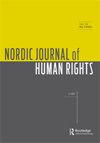Protecting Traditional Knowledge: Lessons from Global Case Studies
IF 1.2
Q3 POLITICAL SCIENCE
引用次数: 3
Abstract
At a time when our globalised world continues to have its focal point in capitalism, people who do not wish to assimilate into a dominant world seek ways to preserve their traditions. While there is no consensus on how to protect indigenous and local communities’ threatened traditional knowledge (TK) in a place where there are diverse national legal systems and a conflict between international instruments, Evana Wright sheds new light on the subject by arguing why sui generis regimes are the best protection for TK. This book serves as a handbook and a starting point for those intending to preserve TK, either with or without the explicit objective of preventing bio-piracy, including academics seeking ways to protect Indigenous and local communities’ rights to culture and self-determination. As Wright writes, protection needs to encompass a holistic concept of TK, and not limit the concept to a specific resource, which calls for transdisciplinary research on the subject. To summarise, Wright stated that the need to protect Indigenous and local communities’ TK comes from the continued acts of bio-piracy – bio-colonialism – around the world (14). The case studies in the book are Peru and India, two countries with a long history of having indigenous and local communities being exploited by industries and others who want to use and, in many cases, be granted patents for the use of their resources for different purposes (47). As contracting parties to the Convention on Biological Diversity (CBD) and the additional Nagoya Protocol, Peru and India have established regimes for protecting TK with respect to the sustainable use and development of biological resources (61). Free prior informed consent before accessing resources associated with TK and equitable sharing of benefits arising from such access is essential to international instruments and, thus, should permeate the national regimes, Wright states (196–197). As an attempt to argue for sui generis regimes as the best protection of TK and the possibility for diverse countries to establish them, Wright analyses the regimes in Peru and India through the lens of self-determination and applies the findings to an Australian context. Before moving on to its highlights, I will outline the book. In the introductory chapter, Wright explains the importance of protecting TK and discusses the essential international instruments, such as the CBD, the Nagoya Protocol, and the United Nations Declaration on the Rights of Indigenous Peoples. She also provides reflections on the relevance of selfdetermination as a lens to look at the need to protect TK. Furthermore, Wright defines TK according to the World Intellectual Property Organization as ‘the know-how, skills, innovations, practices and teachings and learnings of Indigenous people and local communities’ (11). The four following chapters present a comparative analysis of the central aspects of the regimes in Peru and India: historical legal backgrounds, institutions and funds, access and benefit sharing, and databases and registers. Whereas Peru has established a regime that focuses on and allows Indigenous and local communities to influence decisions regarding保护传统知识:来自全球案例研究的教训
在我们这个全球化的世界继续以资本主义为焦点的时候,那些不希望被一个占主导地位的世界同化的人寻求保留自己传统的方法。虽然在一个国家法律体系各异、国际文书之间存在冲突的地方,如何保护土著和地方社区受到威胁的传统知识尚未达成共识,但Evana Wright通过论证为什么独特的制度是保护传统知识的最佳方式,为这个问题提供了新的视角。对于那些有意保护传统知识的人来说,这本书既是一本手册,也是一个起点,无论是否有明确的目标来防止生物盗版,包括寻求保护土著和当地社区文化和自决权利的学者。正如Wright所写,保护需要包含传统知识的整体概念,而不是将概念限制在特定资源上,这需要对该主题进行跨学科研究。总而言之,Wright说保护土著和当地社区的传统知识的需要来自世界各地持续的生物盗版行为——生物殖民主义(14)。这本书中的案例研究是秘鲁和印度,这两个国家的土著和当地社区长期以来一直受到工业和其他想要将其资源用于不同目的的人的剥削,在许多情况下,这些人还获得了将其资源用于不同目的的专利(47)。作为《生物多样性公约》(CBD)和《名古屋附加议定书》的缔约国,秘鲁和印度已经建立了有关生物资源可持续利用和开发的传统知识保护制度(61)。Wright指出(196-197),在获取与传统知识有关的资源之前获得自由的事先知情同意以及公平分享这种获取所产生的利益对国际文书至关重要,因此应渗透到国家制度中。赖特试图论证自成一体的制度是对传统知识的最佳保护,以及不同国家建立这种制度的可能性,他通过自决的视角分析了秘鲁和印度的制度,并将研究结果应用于澳大利亚的背景。在进入重点部分之前,我将概述这本书。在引言部分,赖特解释了保护传统知识的重要性,并讨论了重要的国际文书,如《生物多样性公约》、《名古屋议定书》和《联合国土著人民权利宣言》。她还提供了关于自决的相关性的思考,作为一个镜头来看待保护传统知识的必要性。此外,Wright根据世界知识产权组织将传统知识定义为“土著人民和当地社区的知识、技能、创新、实践、教学和学习”(11)。以下四章对秘鲁和印度制度的核心方面进行了比较分析:历史法律背景、机构和资金、获取和利益分享、数据库和登记册。鉴于秘鲁建立了一个制度,重点关注并允许土著和地方社区影响有关的决策
本文章由计算机程序翻译,如有差异,请以英文原文为准。
求助全文
约1分钟内获得全文
求助全文
来源期刊

Nordic Journal of Human Rights
POLITICAL SCIENCE-
CiteScore
1.00
自引率
25.00%
发文量
29
期刊介绍:
The Nordic Journal of Human Rights is the Nordic countries’ leading forum for analyses, debate and information about human rights. The Journal’s aim is to provide a cutting-edge forum for international academic critique and analysis in the field of human rights. The Journal takes a broad view of human rights, and wishes to publish high quality and cross-disciplinary analyses and comments on the past, current and future status of human rights for profound collective reflection. It was first issued in 1982 and is published by the Norwegian Centre for Human Rights at the University of Oslo in collaboration with Nordic research centres for human rights.
 求助内容:
求助内容: 应助结果提醒方式:
应助结果提醒方式:


